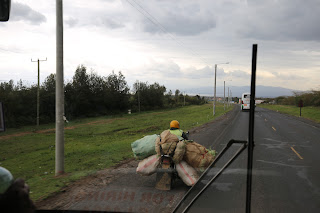‘Do you like your water warm or cold?’....ie refrigerated or non-refrigerated.
I had been looking forward to this day - I’ve had this vision in my head for ages of driving out of Nairobi and seeing the Great Rift Valley for the first time.
Ahead of that we spent the morning at a Giraffe and an Elephant sanctuary. Both have a focus of rescuing the young from the wild. It’s pretty shocking in that the main reason why both sets of young find themselves alone is due to human poachers. In fact basically 75% are human related and then you can debate whether the remaining 25% (basically drought) is human related or not. I would argue yes. Drought has plagued Kenya in recent years. For example, very few mothers get killed by lions or the hyenas in the Masai mara as is commonly thought.
The highlight today was getting a kiss from Doris the giraffe and not being smacked by Kelly the headbutter. Most of the crew bottled it. But safe in the knowledge that giraffes do not have any desease to speak of (they have an immaculate immune system), their saliva also being a well known anti-sceptic I made the plunge of sticking the candy inbetween my lips, leant forward and hoped for the best. I got off lightly with only a little slobber on my chin!
In the sanctuary of 120 acres they tend to hold the giraffes for anywhere between 15 and 30 months before releasing them. They get crazy tall too, up to 5.5 meters weighing in 1.8 tonnes - heck they are born 2 meters tall!
At the Elephant sanctuary they will only reintroduce the elephants into the wild after anywhere between 5 and 8 years and usually find them under the age of 3. They are phased back into the wild by effectively giving them a day release so that they begin to form relationships with the elephant tribes and only after they are properly accepted into a tribe are they formally set free. It’s a massive lead time and preparation program.
Interesting elephant facts:
- they get 6 sets of teeth
- each set lasts for circa 10 years
- they live up to 70 years
- and it is true that elephants never forget, they remember everything!
- not so interesting but more disturbing: numbers are down to 300,000 vs the 3 million in previous decades. Flipping horrendous.
Tommy and the Elephants:
https://www.youtube.com/watch?v=LlEab6B-aVo&index=2&list=PLv9ZA_FgUOwK90wUOVRfAIglzYcBnbNJb
Tommy and the Elephants:
https://www.youtube.com/watch?v=LlEab6B-aVo&index=2&list=PLv9ZA_FgUOwK90wUOVRfAIglzYcBnbNJb
On the way out of Nairobi we passed the national stadium where all the greats have raced and the largest slum in Nairobi and the second largest in Africa, the Kimbara slum. The sohetto slum in S Africa is only larger. The Kimbara has the best part of a million people living there and it is a sprawling metropolis made up of metal (corrugated iron) and wood shacks.
2 hours into the trip the Rift Valley ermerged in all its glory. You could see for miles as the clouds rolled across the stunning landscape. It was here we stopped for some pictures. In Nairobi the altitude is 2,000 meters already and now we were at 2,500, higher than most Alpine ski resorts.
Another hour in we stopped for lunch. I opted for the infamous Ugali (the staple Kenyan maze diet) - that, altitude and EPO being the winning ingredients for Kenyan long distance running. We then headed west to Nakuru one of the larger Kenyan cities toward the green tea plantations and rolling hills of Kericho, our home for the next 4 days.
One quick note on the drive. My god it is bonkers. The overtaking manoeuvres are out of control. I reckon we had 10 near head on collisions with either our bus driver overtaking on the lane of the oncoming traffic or visa versa.






































































No comments:
Post a Comment